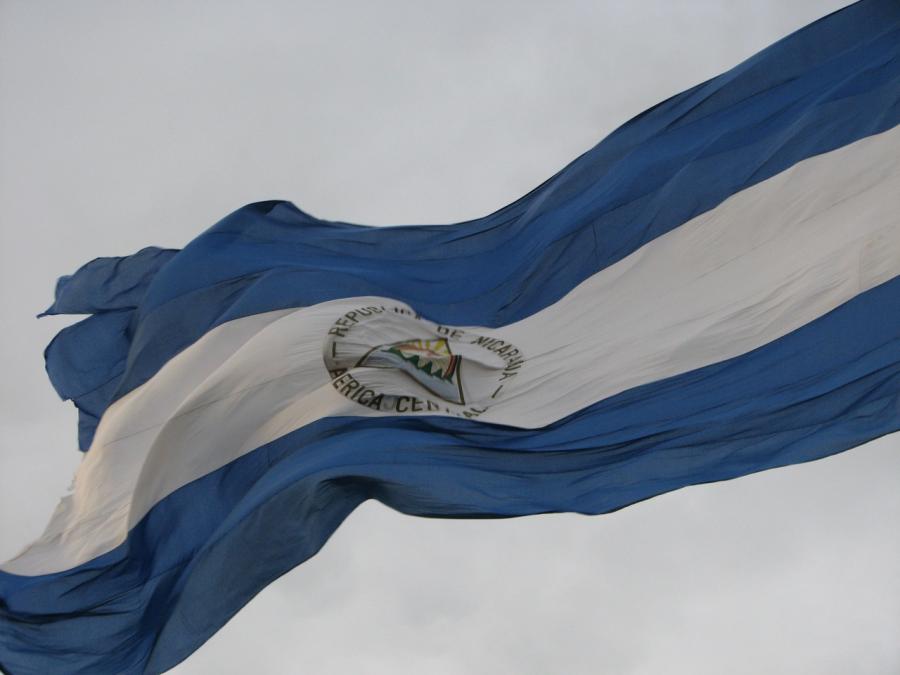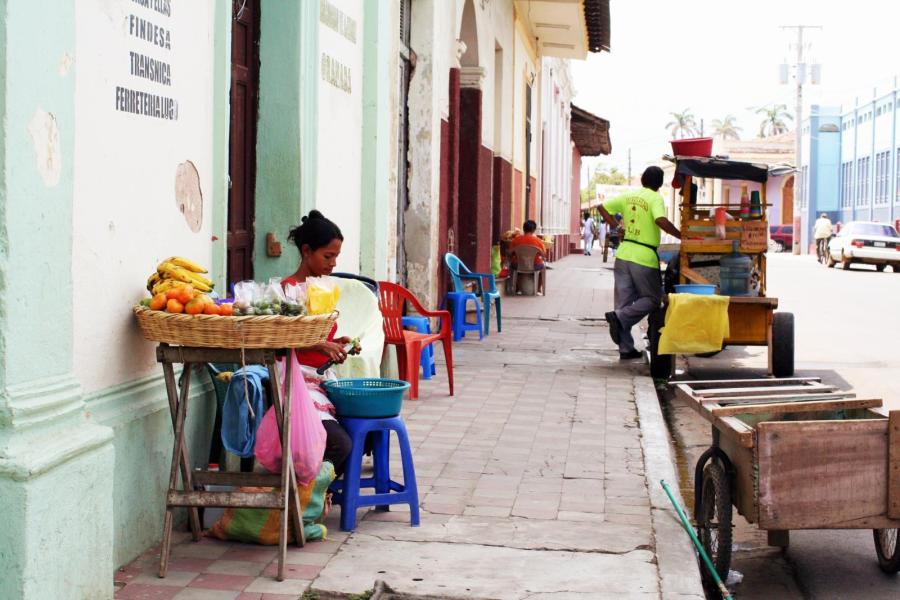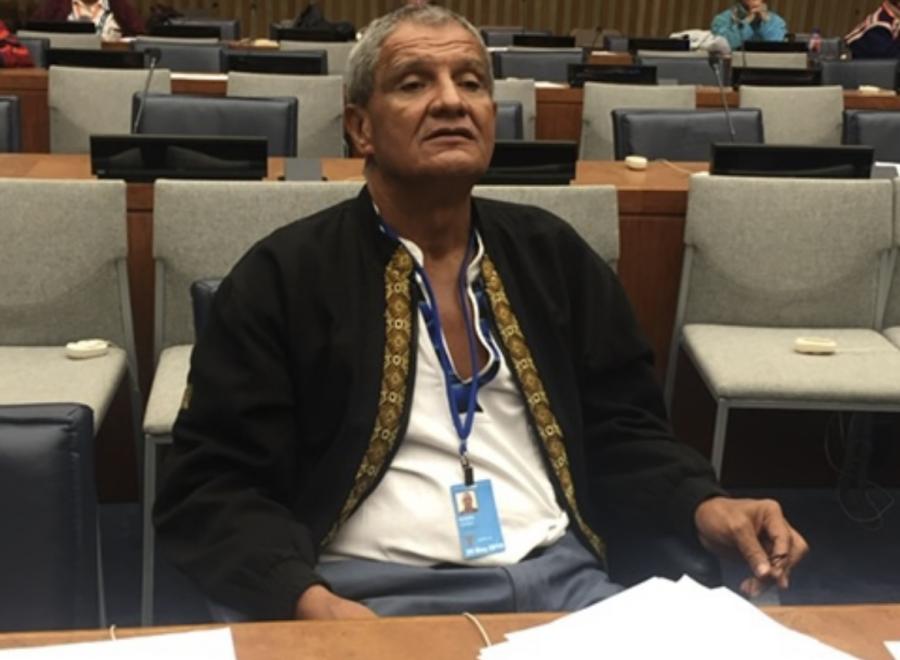Ervin Hogdson leaned forward in the dóri (dugout canoe) his father handcrafted from a massive rainforest tree. Grown and made on community lands, the prow of the boat rose and fell pointing toward the island village of Rama Cay (pronounced “Key”), the figure-eight-shaped sanctuary in the center of the lagoon, which is the Rama capital island, officially Caribbean Nicaragua. Ervin’s people, the Rama, are struggling to protect and keep sovereignty over their land and survive as a unique culture, but the young Rama environmentalist and teacher was hopeful.
The Sunday sun moved through an ancient forest, and shafts of light shone on his round, stern face. Sergio, Ervin’s brother, directed the engine and spoke gently in English Creole to his teenage son, scooping water out of the boat.
“We need to plaster the sides,” Ervin said calmly, looking around the boat for improvements. “I like sails better” he explained, always examining. “They are quieter.” Sergio responded with a deep, brown-eyed smile. Their mother was silent, patiently holding some market goods acquired by the trade of fish. In all directions, the colorful sails of fishermen’s dóris soared across the water, saying, “This is Rama territory; this is Rama identity.”
Ervin had made the journey from the old pirate town of Bluefields to Rama Cay much more frequently since his enrollment at University of the Autonomous Regions of the Caribbean Coast of Nicaragua, which offers training and education for the Indigenous Peoples of the region. “I have been a student, a teacher, and doing social programs for many years now,” Ervin explained modestly. As one of only two Rama seeking a master’s degree, Ervin feels great responsibility in giving a voice to his people. Much of their rainforest land has been divided into preserves and parks, and the Rama have little power. Violence, theft, and ecological devastation have all been the agents of Rama marginalization, pushing their culture and way of life toward the edge. To avoid human rights atrocity, conservation refugee status, and cultural assimilation, Rama need “education for life,” Ervin said, approaching the island. “My father went to a Mestizo school and learned how to do nothing, and it killed our language,” Ervin explained, waving to community members who waited patiently on the dock. The most critical aspect of Rama culture, ecological knowledge, is the one that Ervin is most focused on. Deforestation is rampant, the agricultural frontier is expanding, and climate change has swallowed a third of the neighboring Pearl Keys. All of them threaten Rama lands and ways of life. “That’s why environmental education is so good for the Rama,” he said. He listed all the benefits: it preserves the Rama cultural value of ecology in such relevant ways; it engages all Rama in world issues and helps them take hold of the reins; it is communication; and it is Rama led.
“There’s an old Rama tradition,” Ervin explained, looking up at the clear blue sky, “that if visitors come in good weather, they bring good luck to the whole community.” We were greeted on the island by nieces and nephews, Ervin’s father, and a few chickens pecking at the sand. The dozens of Rama houses appeared woven into the two hills of Rama Cay, with the primary-school building crowning the near hill. A Moravian church sat atop the hill across the commons.
The Rama, who number a few thousand, are semi-nomadic, shifting seasonally with agricultural subsistence intricately tied with the surrounding rainforest and a base of skilled fishing throughout the lagoon. “We live entirely with our land,” Ervin explained. “I farm just over there,” he said, pointing eastward to the rainforest across a majestic lagoon. “Most men fish, but I do not fish.” He explained that he is one of the community’s high school teachers.
Rama villages along the rivers and on islands are within a territory called the Southern Atlantic Autonomous Region. This region is governed in part by the Indigenous Peoples, but with all the exploitative interest in the area, the path to full autonomy and real protection of community lands will be, and has been, a long one.
Ervin explained that the community has a tribal council of elders who communicate with the mestizos and Nicaraguan government, “but we still lack a voice.” There was a land demarcation in October, a huge political step toward granting official land titles. However, just like so-called paper parks, illegal use of the Rama territory and government disregard make “paper property” a sensible term to use in describing their territorial integrity.
The history of Rama lands and outside interaction is a bloody one. “The war was hard for us all,” Ervin reflected, sitting with his father, a lifelong fisherman, looking out over the water. The Contra/Sandanista war of the 1980s much about land reform. There has been a lot of recent violence against the Rama over their lands, and many people have died. “I’ve been threatened by loggers myself,” Ervin said, describing a time when he was tending his forest plot and found people on his land. The Rama live in one of the largest remaining chunks of rainforest anywhere in the world, and everyone wants a piece of their territory. Those most knowledgeable about it, the Rama themselves, are the first to be silenced.
In the afternoon, Ervin walked with one of his students, Edwin, to the top of the hill where the primary school sits. Edwin, now a high school student, is tall and skinny, wearing long black hair, as is traditional for the Rama. In front of the building he touched the red hibiscus flower he planted when he was a student there. “We are going to do many things for environmental education,” Ervin said. He talked about the possibilities for an office of the environment for Rama Cay. “I am teaching environmental education in sciences classes now. I am having students do projects where they can educate the entire community.” One such example is elementary-age students visiting the homes of community members and parents, making sure there’s no trash on the ground. The recent coming of waste items such as plastic wrappers and bottles has created a problem for the community, particularly where there is no infrastructure that might allow for its removal. Ervin explained how students study topics like pollution, climate change, and sustainable energy (the school has a few photovoltaic solar panels, and Ervin talks excitedly about wind energy), but most importantly natural resource management and conservation.
A new program within the Rama community has been the integration of Indigenous patrolmen to protect the land officially from loggers, poachers, outside farmers, and corporations that, among other things, have been trying to build a canal freight corridor right through Rama lands. The success of the programs rests largely on the Rama ability to keep them organized and to stay educated “for life” in changing times. As many outsiders look greedily toward their land, the Rama are rapidly taking up arms. Their weapons of choice: pencils, books, and good teachers.
Ervin and Edwin walked toward the commons, where the church congregation was beginning to assemble. An elderly woman in the village had passed away the previous day, and the church bells were echoing on the opposite hill as the village children ran to the area outside the woman’s home. Ervin talked softly in Creole with Jimi, the town electrician, who just came from collecting monthly electricity bills. Jimi, a relative of the dead woman, runs a generator on diesel fuel bought in Bluefields, enough to give lighting to some houses and enough to power the nighttime lights that were recently installed on the island. Ervin made a joke about the roosters who crow all night now, confused by the “street lights” lining two or three dirt paths on the island. Jimi explained that it is expensive to buy fossil fuels from outside, but the village has come to demand it more and more.
Everyone slowly gathered in a small hamlet courtyard as Ervin’s grandfather played a piano with a Rama groove, and a Rama preacher gave a sermon. There was respectful silence as gifts were given to the family and the woman was remembered. Her coffin was hand carved by village men using the same tools they use to carve fishing dóris.
At sunset, Ervin and his family shared a pot of coconut rice and shrimp harvested and grown by Rama rainforest farmers and Rama fisherman. A young boy behind Ervin’s house climbed up a breadfruit tree to cast a large tasty prize down to his father in the twilight. “I always ask my students, ‘Why is it important for Indigenous Peoples to protect natural resources?’” Ervin said. “My teacher in college always asked me that because I am Indigenous. My mother always asked me why I wanted to be different; I always told her, ‘You do not need to be different to make a difference.’”
In the morning, Ervin’s sister was preparing Rama coffee and drum fish in wooden bowls in the common kitchen downstairs, when Ervin’s niece Anne-Linny poked her head around the corner of the upstairs room to tell him he had a call from blueEnergy, a sustainable energy and environmental nonprofit organization. The person on the phone said that three blueEnergy representatives would be there that afternoon to do a health assessment, asking their friend Ervin for a place to sleep. Ervin opened his laptop, leaning against his second-floor stilt-house wall, which he and his father built and painted light blue. “Just imagine,” he said, thinking about his students. “Rama could be leaders for healing the global environment.” His eyes followed Anne-Linny and her bright colors as she disappeared behind his sister’s house.
Ervin laughed when I called him innovative. He said that his days are very busy, even though he follows a different pattern, a different type of busy, than that of his community. “I am the only Rama with a computer,” he said. “Many people think it is strange, wondering ‘What is Ervin doing up there?’ But the Internet opens many opportunities. I am a Rama, but I am doing many things new to us.”
Ervin has been able to connect with people all over the world, build the first Rama website, be a point-man for researchers and for national newspapers such as La Prensa, present at Indigenous rights conferences across the region, show the world Rama language successes, work with NGOs, house travelers, and achieve higher education. He has grown a voice for the Rama, and most importantly, Ervin has become a role model for his students, particularly in environmental education. “The Rama need to know how to deal with big companies, governments, nonprofits, everyone,” he said.
“Our efforts in environmental education need to be successful like our efforts to save the Rama language,” Ervin said. Once thought dead, the Rama language, a crucial piece of Rama relationship to their universe, has come back with the internal efforts of community members. “Miss Norah Rigby was an elder here who saved our language,” he said. “Now over 60 people know at least some Rama; children, too.”
To save the Rama land, just like the Rama language, the role of culture is at the center. “Language is observation about the environment,” Ervin said, “and identity is observation turned into a way of life. These things are all tied together.” Ervin held up a 2010 calendar that he and other community members had made. Each month uses a different Rama phrase to describe a Rama cultural activity in relation to the ecosystem. November, for example, has a picture of a rainbow-colored fishing dóri. Under the picture it says “Ning tukan ki nsut aakarngi yaabra pulkat ki an tuali kaali tataara.” The phrase is translated into English, Creole, and Spanish: “In this month we sail in the north wind and the waves are big.”
We took a walk to Ervin’s brother’s house, just over the hill beyond the schoolhouse. It was a school-less Monday, a day to celebrate and respect the elder who had just died. Ervin slipped into the shade of his brother’s thatched home and greeted Sergio. “My brother is doing many good things,” Sergio said as he walked into the open room to pick up some fishing net. He held the net examining it in the light coming through the open window. His body is tall and lean, worked by the sun. Sergio, who has been fishing all of his life, is very aware of the dangers creeping into the waters his people have lived with for millennia. “My territory is what I observe and use,” he said in broken English. He explained that his territory has been increasingly encroached upon by commercial fisherman who are taking more from the lagoon than the Rama know is sustainable.
Alexander, Sergio’s teenage son, walked into the room to talk to his father. Sergio looked at his son hopefully, knowing that Alexander, a bright and peaceful young boy, will carry his knowledge of the land and waters into the Rama future.
Next door, smoke rose softly out of the house of Ervin’s sister, Cordillia. She was cooking rice grown by her husband and fish caught by him, throwing banana peels to the chickens that pecked below. Anne-Linny handed her mother a dead rabbit to be cooked over a wood fire. Pigeons watched from above, sitting calmly on the roof as a pig meandered over the rocks by the water and a small white and black monkey fiddled with the rope around its body on the neighbor’s porch.
Cordillia sat down to do the hard work of shaving coconuts and Great-Grandmother came over to joke and help in the work. As Ervin and Sergio talked, a “Spaniard” (the Rama term for non-Indigenous Nicaraguans) who had come onto the island with cameramen, took a picture, saying nothing to the men, and walked away, his shirt saying, “Travel Nicaragua!” Even if it were offensive, Ervin said nothing; he simply smiled at Sergio.
“We are resilient,” Ervin laughed, as Anne-Linny worked hard to draw a map of the world on a piece of paper from his notebook, using the smooth rainforest wood of the fishing dock as a support. “My grandmother reminded me of a time,” Ervin said, “when I was eight years old (about the same age as Anne-Linny), and a terrible hurricane came through the land. While the forests were shaken and the island was ravaged, a group of villagers stayed on the island to protect the animals, running from one side of the island to the other, trying to get away from the wind. It was crazy, but everyone lived.”
At the water, the family of the woman who died prepared to carry her over the waves. “They will take her to a sacred place in the rainforest, and they will put her to rest in the Rama way,” Ervin said. The next day school would be in session and Ervin would be teaching. And from there, the Rama will be fighting to protect this place. “Our identity is our land,” he said. Walking to the dock, he pushed his dóri into the water, at home.
Will Meadows is an environmental steward and activist, based in Chicago and Washington, D.C. He’s currently finishing a degree at Lawrence University in Wisconsin. This is his first piece for Cultural Survival Quarterly.



